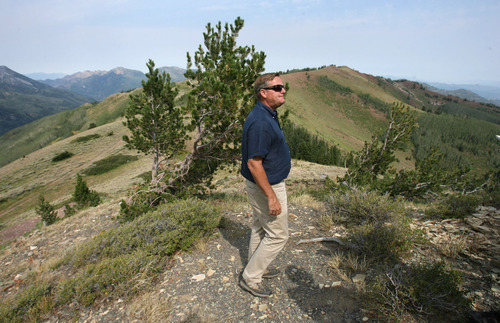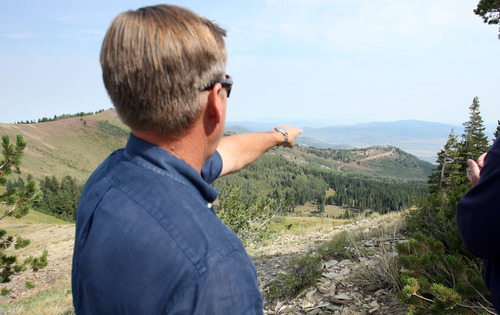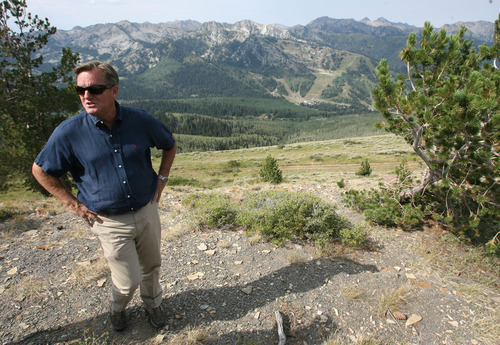This is an archived article that was published on sltrib.com in 2012, and information in the article may be outdated. It is provided only for personal research purposes and may not be reprinted.
Solitude • A hawk circled overhead and a mountain biker flashed by on a nearby trail as Canyons Resort Managing Director Mike Goar stood on a ridge Monday, pointing out the alignment of the proposed SkiLink gondola to Solitude.
The exact point where the controversial gondola would pass from Summit County into Big Cottonwood Canyon was obscured by a little peak along the ridge, several hundred yards west of where Goar parked his vehicle at the end of a rutted four-wheel-drive road servicing mountaintop telecommunications towers.
But even from that distant perspective, Goar was able to convey his message: that a gondola could be built without degrading the environment, certainly without impinging on water quality in Big Cottonwood Creek far below.
And, because the 11,000-foot-long gondola would not have an unloading station on the ridge, he also emphasized how it would not be likely to impact backcountry skiers — another source of opposition to the only concrete proposal out there right now to connect any of the seven ski resorts of Salt Lake and Summit counties.
"This could differentiate us [Utah's ski industry] from other ski states and regions," said Goar, who joined Canyons in 2007 after 26 years at Solitude Mountain Resort.
Goar's assurances provided little comfort to Laura Briefer, water-resources manager for the Salt Lake City Department of Public Utilities.
Contacted after the Goar-led tour, she said building in the city's watershed remains a great concern, particularly if the process is advanced through federal legislation.
Rep. Rob Bishop and other Republican members of Utah's congressional delegation are sponsoring a bill that would require the U.S. Forest Service to sell 30.3 acres of hillside to Talisker Inc., the Canadian company that owns Canyons and other Summit County properties.
The sale would remove the Forest Service from the regulatory process governing the proposed gondola. That would eliminate a large potential roadblock because the agency's master plan for its lands in the central Wasatch Mountains does not permit ski-resort expansion.
Approval of SkiLink still would be required at the local level, with Salt Lake County calling the shots on the proposed uses of private lands in the gondola right of way, while Salt Lake City would weigh in on the project's potential effect on watershed.
But with the federal legislation, Briefer said, "Talisker and Canyons are asking to be conveyed a piece of watershed lands, protected under a 1934 law, without any local public process. That sets a huge precedent with respect to how decisions are made in our critical source-water areas."
Even if the congressionally mandated sale is changed to an order requiring the Forest Service to give Talisker a special-use permit — a possibility the city learned of recently, she said — "it doesn't matter. It's the same result."
Goar said he knew of no new developments at the congressional level. Since bills move slowly at that level, he has been working to explain the proposal to local government officials and to answer their questions.
"That's important and time well spent," he said of conversations with officials from Summit and Salt Lake counties, as well as city water watchdogs.
Monday's tour was part of that education effort. A small news media group was invited to see the proposed alignment, with Goar believing that seeing the terrain would assuage concerns about the gondola's potential impacts.
His route to the site followed a gated private dirt road branching off of Guardsman Pass. The privately owned lands on both sides periodically displayed debris left over from the area's silver-mining days, while the road's modern use for hiking and mountain biking was evident as Goar drove past an aged man with walking sticks and two mountain bikers pausing to gain their breath after pedaling up a steep stretch irreverently known as "Puke Hill."
From the mountaintop array of telecommunications towers and later from the Solitude parking lot, Goar showed how the route crosses through a mixture of aspen stands, conifer trees and open hillsides dotted with sagebrush, grasses and wildflowers.
The gondola would require 25 towers, he said, with the holes for each to be dug by hand. Helicopters then would fly in the steel towers and dump buckets of concrete to hold them in place.
"It's been done before, but it's quite a feat," Goar said, noting the total area of disturbance would be less than an acre.
Numerous trees would have to be cut down, more on the Big Cottonwood side, but he pledged that a silviculturist would be brought in to identify trees for removal.
The corridor generally would be about 70 feet wide, Goar said, but the edges would be tapered frequently to create a more natural appearance rather than a straight line.
"The more we can depict these open areas as a series of meadows," he said, "the better."
While Goar said the plan eliminates the need for a maintenance road on the Big Cottonwood side, Briefer was skeptical.
"There will need to be an access road to maintain it," she predicted, "and to provide access for potential emergency situations."
Twitter: @sltribmikeg —
SkiLink claims
Canyons Resort is projecting a gondola connecting it to Solitude Mountain Resort would:
• Attract 75,000 new skiers in its first year, 150,000 annually thereafter.
• Inject $51 million a year into the Utah economy, plus $3 million in tax revenues.
• Lead to the creation of 500 jobs.
Source: Canyons Resort













